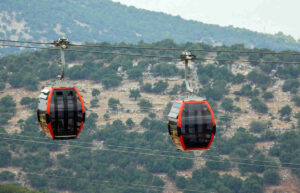As we mentioned in this other post, there are other places of interest near the Roman Theater of Amman. Although this extraordinary site is the great symbol of tourism in the Jordanian capital, you can dedicate more time to what its surroundings hide, as they are full of culture and history. Specifically, four places that we list below: the odeon, the forum, the Folklore Museum and the Museum of Popular Traditions.
The Odeon
Built in the 2nd century, it is the ‘little brother’ of the Amman Theater. And although its size is not comparable, it has nothing to envy in terms of beauty and evocative power. In fact, its entire seating area is preserved, giving a feeling of intimacy. Most likely, this venue was used for shows where perfect acoustics were sought, such as musical concerts for an audience of about 500 spectators. And at the time it must have had a wooden roof that helped in this objective, in addition to protecting the public and the artists from the rain or direct sunlight. Like its neighbor the theater, small performances are still held here from time to time, such as the Al Balad Music Festival, dedicated to traditional music.
The Forum
The forum, as in any other Roman city, was the great public square. And Amman (formerly Philadelphia) had its own. What remains today of that forum is the alignment of columns on its north side, which helps us to imagine its size: about 100 meters long x 50 meters wide. Judging by the buildings located on its perimeter (odeon, theater) it must have been a very lively place, which acted as a meeting point for its citizens. Today, the Hashemite Plaza takes up its legacy: renovated in 2014 with modern furniture and decoration, it is also a regular venue for social events.
Museum of Popular Traditions
Not to be confused with the Folklore Museum, which we will discuss below. This one is located on the left-hand side of the Theater and is a small exhibition center where you can learn about some characteristic elements of the local popular culture. In particular, typical costumes from the different regions of the country, both male and female, whether everyday or formal. Special importance is given here to head accessories, both scarves and caps, headbands, jewelry or turbans. Another attraction of this small museum are the mosaics brought from Jerash and Madaba, two important Roman cities that later maintained their status in Byzantine times, standing out for the numerous mosaics that decorated the floors of their stately homes.
Amman Folklore Museum
To the right of the Roman Theater is this other museum, with a theme similar to the previous one, although with slightly different pieces on display. Here,
Therefore, it is worth visiting the Roman Theater of Amman with time, not only to learn about this spectacular ancient infrastructure in depth, but also to dedicate time to its surroundings, where these other four points of interest are located.



